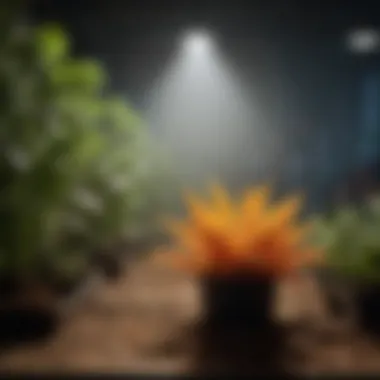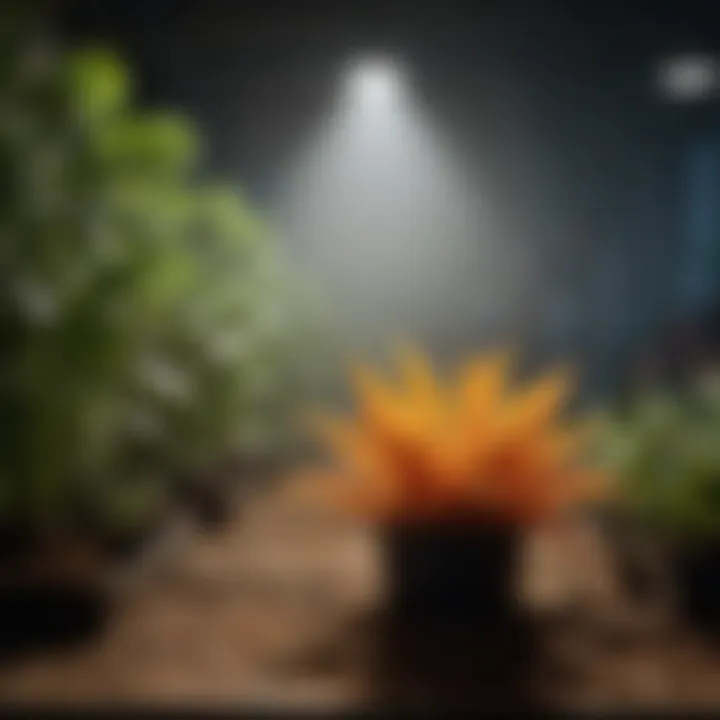Efficiency of High Pressure Sodium Grow Bulbs


Intro
The world of horticulture has always been influenced by the interplay between technology and nature. High Pressure Sodium (HPS) grow bulbs have carved a niche for themselves in this domain, playing a crucial role in enhancing plant growth. Their ability to offer a spectrum of light that closely mimics the sun's energy while consuming relatively low power has made them a popular choice among farmers and horticulturists alike. This article aims to dissect the characteristics, benefits, and practical applications of HPS bulbs in modern horticulture.
Overview of the Topic
Definition and Importance
High Pressure Sodium bulbs are a type of gas discharge lamp that is widely used in horticulture. Unlike other bulbs, HPS emits a warm yellow to orange light, which has proven effective in promoting flowering and fruiting in a variety of plants. These bulbs are particularly significant in indoor growing setups, where natural sunlight is limited. The right balance of light, temperature, and humidity can drastically affect crop yield and health, making HPS a valuable resource.
Current Trends
As the demand for sustainable agricultural practices rises, professionals are increasingly looking toward efficient lighting solutions to optimize their yields.
- The use of HPS bulbs has seen a resurgence due to their improved energy efficiency over previous generations.
- Farmers are now employing advanced growth systems that integrate HPS technology with other innovative lighting fixtures, creating hybrid solutions that maximize light exposure.
Key Techniques and Practices
Step-by-Step Guide
- Choosing the Right Bulb: Select an HPS bulb with the appropriate wattage for the size of your grow area. A higher wattage will generally provide more intense light but requires careful management to prevent overheating.
- Setting Up the Fixtures: Install the bulbs in an adjustable fixture to enable flexibility in height. This is crucial as plants grow, allowing you to keep the light at an optimal distance.
- Monitoring the Environment: HPS bulbs generate heat; thus, maintaining proper ventilation and temperature control is essential. This prevents heat stress on plants and promotes healthy growth.
- Using Timers: Automated timers can help regulate light cycles, which is important for various growth stages of plants. For example, during vegetative growth, plants may benefit from 18 hours of light and 6 hours of dark.
- Regular Maintenance: Check your bulbs and fixtures regularly for signs of wear or reduced output. Replacing bulbs at the recommended intervals ensures that your plants receive consistent light.
Tools and Equipment Needed
- High Pressure Sodium Bulbs: The core lighting source.
- Reflectors: Helps redistribute light more evenly across the growing area.
- Timers: To automate the light schedule.
- Thermometers and Hygrometers: For monitoring temperature and humidity levels.
Challenges and Solutions
Common Obstacles
While HPS bulbs are effective, farmers may encounter several hurdles:
- Heat Management: Excess heat can lead to plant stress if not managed.
- Energy Costs: Despite their efficiency, long-term energy usage can still strain budgets.
Innovative Solutions
To mitigate some of the issues associated with HPS technology, consider the following strategies:
- Cooling Systems: Incorporating cooling fans and air conditioning units can help manage heat levels during intense light cycles.
- Energy Audits: Regularly assess energy consumption and explore ways to reduce costs, such as adopting LED technology alongside HPS for certain growth stages.
"The effective integration of HPS bulbs can optimize plant growth and yields significantly, making them a cornerstone of modern horticultural practices."
In summary, High Pressure Sodium grow bulbs offer an effective means to enhance plant growth in controlled environments. Understanding their functionality, coupled with thoughtful techniques and awareness of challenges, can set farmers up for success in their horticultural endeavors.
Fundamentals of High Pressure Sodium Grow Bulbs
Understanding high pressure sodium (HPS) grow bulbs is crucial for modern horticulture. They have carved out a niche in indoor gardening and commercial greenhouse applications. By examining the principles behind HPS technology, growers can harness the full potential of these bulbs for their plants.
What Are High Pressure Sodium Grow Bulbs?
High pressure sodium grow bulbs are a type of gas discharge lamp. Typically recognized for their distinctive yellow-orange glow, they are primarily utilized in horticultural settings, providing a spectrum that promotes robust plant growth. When the electricity runs through the arc tube, it ionizes the neon and sodium gas inside, generating light. Their efficiency has made them popular among gardeners looking for strong lighting solutions.
The Science Behind HPS Lamp Technology
At the heart of HPS technology, you'll find some interesting science. The lamp consists of a glass outer envelope that houses the arc tube, which contains a mixture of gases. When the bulb is energized, the gas within becomes ionized, leading to a process where electrical energy is converted into light energy. The emitted light primarily consists of wavelengths in the red and orange spectrum, which are particularly beneficial for flowering and fruiting stages of plant growth.
Using the unique properties of sodium gas, HPS bulbs not only produce a bright light but also have a higher efficiency rate compared to other types of horticulture lighting. This means that growers can get more light output with less energy consumed.
Chemical Composition of HPS Bulbs
The effectiveness of HPS bulbs comes from their intricate chemical makeup. Standard HPS bulbs contain sodium, mercury, and a few trace elements, which together produce the desired light spectrum. Sodium is the key player here, as the majority of the light produced falls around the 589 nm wavelength, which is particularly effective for promoting photosynthesis. The balance of these chemicals ensures that the bulbs not only emit light efficiently but also maintain a longer lifespan, reducing the need for frequent replacements.
In summary, HPS grow bulbs stand as a testament to innovation in horticultural lighting. Their scientific foundation, coupled with their practical applications, establishes them as an essential tool for anyone serious about cultivating plants. Their unique spectrum and energy efficiency are significant factors that justify their widespread use in indoor gardening and commercial farming.
Advantages of Using High Pressure Sodium Bulbs
When it comes to horticulture, the tools we choose can make or break our gardening success. High Pressure Sodium (HPS) bulbs present a multitude of benefits that are hard to overlook. From facilitating healthy plant growth to offering unique energy efficiency, these bulbs hold a prime place in modern growing practices. The spotlight of this section is on the advantages that stem from utilizing HPS technology and how these benefits translate into practical applications for farmers and horticulture enthusiasts alike.
Light Spectrum and Plant Growth
At the core of any plant development is the light it receives. HPS bulbs emit a predominantly yellow-orange light, which aligns well with the needs of many plants during their flowering and fruiting stages. This rich spectrum enhances photosynthesis, which is crucial for plant growth. For plants that thrive in these wavelengths, the positive impact is evident — increased yield, robust growth, and healthier plant structures.


HPS bulbs are particularly effective for the late growth stages of plants. Many farmers have noticed that flowering plants respond better to the increased red and orange spectrum produced by HPS lighting compared to other grow lights.
"Using HPS lighting for my tomatoes resulted in a 20% increase in yield last season. The color and size of the fruit were noticeably improved too!" - A local farmer's testimony.
Of course, not all plants respond the same way. Some might require different light spectra, particularly during their vegetative stage. However, for those focusing on final growth phases, HPS bulbs often prove to be the favored choice.
Energy Efficiency Considerations
Efficiency is a word bandied about often, but what does it truly mean in this context? HPS bulbs, while sometimes criticized for their initial power consumption, provide a significant upside in terms of overall energy use. Once operational, they generate more light per watt compared to traditional incandescent options. It's about getting the most bang for your buck.
One practical consideration is the lifespan of HPS bulbs. They typically last longer than most other grow lights, often reaching over 24,000 hours of use before needing replacement. When you take into account the cost of purchasing new bulbs frequently, the longevity of HPS lamps contributes to their overall cost efficiency.
Another key point is heat output. Though they do produce heat, which can be a double-edged sword, this aspect can also be used to a grower's advantage. The warmth can help maintain an ideal temperature environment for many crops, reducing the need for additional heating solutions.
Some growers have satisfied their curiosity with comparative studies, finding that HPS bulbs can offer a better balance of light output for the energy consumed when set beside other types of grow lights like LEDs or fluorescent models. When combined with their effective light spectrum, it makes a compelling case for choosing HPS technology.
In summary, using High Pressure Sodium bulbs presents multiple advantages that cater to the serious grower. The specific light spectrum boosts growth during critical phases while their energy efficiency and longevity offer lasting economic value. For anyone serious about improving their plant yields, understanding these benefits is not just useful — it’s essential.
Installation and Setup of HPS Grow Lights
Setting up high pressure sodium (HPS) grow lights is a critical component in ensuring optimal growth for plants in horticulture. The installation process can affect both the efficiency of the lighting and the resulting yield of the plants. Proper setup leads to better light distribution, reduced energy waste, and overall improved plant health. Hence, understanding the elements involved in the installation of HPS grow lights can make a significant difference for any agricultural undertaking.
Choosing the Right Location
Selecting the ideal location for your HPS grow lights entails more than just finding a suitable spot. First off, consider the size and layout of your grow area. Whether it's an indoor garden or greenhouse, the lighting setup must ensure that each plant receives adequate light.
Moreover, the height at which the lights are installed can affect both light intensity and energy efficiency. Excessive height can leave some plants longing for those bright rays while keeping others too close can cause damage due to intense heat. It’s a fine balance.
- Plants like tomatoes and peppers appreciate closer light, while leafy greens might fare better further away.
- Ventilation systems should also be considered since HPS bulbs can generate significant heat. Placing lights in a way that complements the air circulation of the space is vital.
- Accessibility for maintenance is key; avoid spots that are a hassle to reach for replacing bulbs or adjusting fixtures.
All in all, if the setup isn't thought out carefully, the intended benefits of HPS lighting can easily unravel.
Necessary Equipment for Setup
Once the location is set, the next step is to gather the necessary equipment for a successful installation. Here are essential items to consider:
- HPS Bulbs: These come in various wattages—decide on the wattage based on your specific needs.
- Ballasts: They control the electrical current to the HPS bulbs. Don’t skimp here, as the right ballast matches the bulb wattage and ensures maximal efficiency.
- Reflectors: To maximize light distribution, high-quality reflectors help spread the light evenly across the plants. It’s like providing sunshine to every leaf.
- Hanging Equipment: Chains or pulleys might be necessary to adjust the height of the lights as plants grow. They shouldn’t be fixed; flexibility is key.
- Timer Switches: Automating light schedules prevents oversights, ensuring that plants receive consistent photoperiods.
Having this equipment on hand will streamline the installation process, allowing for a more manageable setup experience.
Safety Precautions During Installation
Installing HPS grow lights comes with its set of safety considerations, especially since improper handling can lead to hazards. Here’s a rundown of important precautions:
- Turn Off Power: Before doing anything, ensure that the power supply is shut off. Accidentally zapping yourself isn’t how you want your garden adventure to begin.
- Use Ladder Safety: If the bulbs need to be hung high, make sure to use a stable ladder. It’s all too easy to lose your balance—and that can lead to accidents both for you and your light fixtures.
- Heat Resilience: HPS bulbs get really hot. Use heat-resistant materials for any fixtures or reflective surfaces, and keep flammable materials at a safe distance.
- Proper Ventilation: Ensure that the grow area is well-ventilated to avoid overheating. If the area feels like a sauna, your plants won't be the only ones suffering.
Following these safety precautions not only protects the grower but also goes a long way in extending the lifespan of the equipment.
"The success of indoor gardening relies on more than just good seeds; it's about the entire growing environment."
In summary, the installation and setup of HPS grow lights may appear straightforward, but it's laden with nuances that every horticulturist should heed. Identifying the right location, gathering necessary equipment, and observing safety precautions can transform your horticultural endeavors from ordinary to extraordinary.
Applications in Horticulture
High Pressure Sodium (HPS) grow bulbs play a pivotal role in modern horticulture. Knowing how to make the most out of them can significantly optimize plant growth. In this section, we’ll dive into the various applications of HPS bulbs, highlighting their importance in different gardening setups.
HPS Bulbs for Indoor Gardening
Indoor gardening has surged in popularity. When space is limited, utilizing HPS bulbs can make all the difference. These bulbs emit a light spectrum that closely mimics the natural sunlight plants crave. They provide a robust output that helps plants photosynthesize effectively even in non-traditional and indoor environments.
One of the key advantages of using HPS bulbs indoors is their light intensity. The high lumen output ensures that plants receive enough energy to grow healthy and strong. This capability allows gardeners to cultivate a variety of plants, including those that typically require significant sunlight exposure. For example, vegetables such as tomatoes and peppers, or even flowering plants like orchids, flourish under HPS lights.
However, it's essential to monitor heat levels. HPS bulbs generate warmth, which could hinder plant growth if not managed properly. Fine-tuning the distance between the light and the plants is crucial to maintain an optimal growing environment.
Use in Greenhouses
Greenhouses benefit immensely from HPS bulbs, particularly during the winter months when natural sunlight is scarce. During this time, HPS bulbs can supplement light, fostering plant growth even when outside conditions are less than ideal. In fact, many commercial growers integrate HPS systems into their greenhouses to enhance yields.
The blooming and fruiting phase of a plant's life cycle is notably affected by light exposure. The extended use of HPS lighting can accelerate growth rates, leading to earlier harvests. This is particularly important in a commercial setting, where time equates to money. Growers can maximize profitability by investing in quality HPS lighting.
In a greenhouse setup, it’s also worthwhile to consider the arrangement of these lights. Proper placement can maximize light distribution and minimize shadowing, allowing every plant to receive ample lighting.
Comparative Efficacy for Different Plant Types


Not all plants grow the same way or under the same conditions. Some thrive better in higher light intensities, while others do well in milder setups. HPS bulbs offer a level of versatility that is valuable across a range of plant types.
For instance, leafy greens such as spinach and lettuce require different light conditions compared to flowering plants like sunflowers. HPS bulbs can cater to both groups, though adjustments must be made regarding duration and intensity of exposure. An interesting observation is the responsiveness of certain plant types to HPS lighting; some not only grow faster but also produce higher quality fruits and flowers.
*
- Tomatoes
- Peppers
- Herbs like basil and cilantro
- Flowering plants such as geraniums
Utilizing HPS bulbs can also aid in the regulation of flowering cycles. Some plants, reliant on light duration to trigger blooming, may find their cycles optimized under controlled HPS lighting.
"Harnessing the power of HPS bulbs allows growers to manipulate their environments, leading to exceptional yields and healthier plants."
Thus, whether in an indoor garden or extensive greenhouse, understanding the specific requirements of different plants is key to making the most of HPS technology.
Performance Evaluation of HPS Grow Bulbs
The performance evaluation of high pressure sodium (HPS) grow bulbs is crucial in determining their effectiveness in various horticultural settings. Understanding how well these bulbs perform concerning light output and the resulting plant growth response allows growers to make informed choices that can ultimately influence yield and quality. Performance data contributes significantly to comparative analyses between HPS and other light sources, ensuring that professionals can adopt the best lighting solutions for their needs. Evaluating this performance often reveals the strengths and limitations of HPS technology, shedding light on energy efficiency, light penetration, and spectral efficacy for different plants.
Measuring Light Output and Distribution
Measuring light output involves quantifying how much usable light is emitted by an HPS bulb. This is often done using a tool called a light meter, which gauges the intensity and spectrum of the light produced. A cranky meter or one that’s not properly calibrated can lead to skewed results, so it's vital to maintain equipment in tip-top shape.
Light distribution is equally important — it tells growers how evenly the light spreads across their growing area. An uneven distribution can lead to hot spots or shaded areas that affect plant growth. Commonly, growers encounter the concept of
- PPFD (Photosynthetic Photon Flux Density) which expresses light intensity per area,
- DLI (Daily Light Integral) which measures the total amount of light a plant receives in a day.
Achieving balanced light distribution can be a tricky business, but ensuring uniform coverage helps to maintain consistent growth rates among plants. Partial deficiencies can lead to stretching or underdevelopment, thereby hampering crop yields.
Evaluating Plant Growth Responses
Once light output and distribution are measured, it's time to take stock of how plants respond. HPS grow bulbs tend to produce a yellow-orange spectrum, primarily in the 2000K-2500K range, which is favored by many flowering plants. Observing these growth responses can be subjective but focusing on a few parameters often helps in evaluating this effectively:
- Growth Rate: Keeping an eye on the speed at which plants grow under HPS lights can inform growers about light adequacy.
- Leaf Color and Health: Healthy, vibrant green leaves indicate effective growth, while pale or yellowing foliage may signal deficiencies.
- Flower Development: Pay attention to the number and quality of flowers or fruiting bodies produced, as HPS lights are often reputed for enhancing these traits.
Plant responses also happen to vary based on the species and familiarity with their growth habits. Some plants luxuriate under HPS light while others might miss the more blues or reds provided by alternative lighting methods. This makes continuous evaluation paramount, allowing horticulturists to adjust their practices for the best outcomes.
"A penny saved is a penny earned" is often true in horticulture; reducing wasted energy or resources through careful light evaluation leads to healthier plants and fruitful harvests.
In summary, integrating performance evaluation of HPS grow bulbs into horticultural practice ensures that growers harness their full potential. By measuring light output and distribution accurately, as well as evaluating plant growth responses, professionals can optimize their lighting strategies, ultimately leading to better yields and a healthier growing environment.
Comparing HPS with Other Grow Light Technologies
In the ever-evolving landscape of horticulture, the choice of grow light system can make or break a gardening project. This section's focus on comparing high pressure sodium (HPS) bulbs with other light technologies is crucial for growers seeking to maximize efficiency and plant health. Each lighting type, from LEDs to fluorescents, caps a different set of benefits and drawbacks, making it vital for farmers and hobbyists to weigh these options carefully.
LED Lights vs. HPS Bulbs
LED lights have risen to prominence for various reasons. When it comes to energy efficiency, they have HPS bulbs notably beat. LEDs typically consume 50% less energy than their HPS counterparts, reflecting smaller utility bills and reduced carbon footprints.
But it’s not just numbers; the spectrum of light emitted from LEDs can often be customized. This means growers can tailor light output to the specific needs of their plants during various growth stages, leading to more vibrant flowers and higher yields. Studies have shown that some crops thrive better under the specific light wavelengths produced by LEDs compared to the broad-spectrum light from HPS bulbs.
However, there's a trade-off. LED lights generally come with a higher upfront cost. For farmers counting their pennies, this might raise a few eyebrows. Plus, in larger spaces or commercial settings, the initial installation and setup of LED systems can be more complex.
On the other hand, HPS bulbs are renowned for their intensity. They emit a warm, yellow-orange glow that closely mimics natural sunlight. This can be particularly advantageous during the flowering phase of plant development. Yet, while they’re efficient by some standards, growers should keep in mind that they do produce more heat than LEDs. This adds another layer to climate control needs in the growing environment.
- Pros of LEDs:
- Cons of LEDs:
- Energy efficient
- Customizable spectra
- Lower heat generation
- Higher initial cost
- Complex setup in larger spaces
Fluorescent vs. HPS Lighting
Fluorescent lights, particularly T5 models, are often lauded for their affordability and efficiency in certain applications. They provide a softer light that is less intense than HPS bulbs, making them particularly suited to seedlings or young plants that might be sensitive to stronger lighting. Some gardeners swear by fluorescents for propagating new plants, as they lower the risk of burning delicate foliage.
In contrast, HPS bulbs deliver a stronger light, which is paramount for mature plants during their flowering and fruiting stages. The high intensity provided by HPS fosters robust plant development, potentially resulting in greater yields. But let's not overlook the fact that HPS lights can be somewhat of an energy hog when it comes to operating costs.
Farmers and enthusiasts should also consider the maintenance aspects. Fluorescents generally need replacement more frequently than HPS systems. However, with HPS, users must be vigilant about heat management, given their tendency to elevate temperatures significantly.
"Deciding between lighting technologies isn’t just about preference; it’s a strategic choice that could impact your entire growing operation."
Economic Considerations in Using HPS Bulbs
When evaluating horticultural lighting, especially in a world that increasingly prioritizes sustainability and cost-effectiveness, the economic implications of using high pressure sodium (HPS) bulbs hold significant weight. These bulbs promise tangible benefits, but they also require careful consideration of both initial and operational costs. Understanding where the dollars go—and how they come back—can give farmers and horticulturalists a clearer picture of their financial lifecycle.


Initial Investment and Long-Term Savings
Investing in HPS bulbs can initially seem like a hefty expense. The upfront cost typically covers the bulbs themselves, along with necessary equipment like reflectors and ballasts. On average, the cost of a quality HPS bulb ranges approximately from $100 to $250, depending on the wattage and brand. However, it's essential to look beyond this initial outlay.
In many instances, the long-term savings associated with HPS technology make it worthwhile. For example, while the energy consumption per watt may be higher than some alternatives like LED, HPS bulbs are known for their effectiveness in producing strong, high-intensity light. With appropriate usage, their longevity can translate into years of utility. Many HPS bulbs last anywhere from 24,000 to 26,000 hours under ideal conditions. Thus, when broken down over their lifespan, the annual cost of ownership can be significantly lower than expected.
Moreover, the robust light spectrum of HPS bulbs is conducive to accelerating plant growth stages, potentially shortening growing cycles and leading to more harvests in a given period. Consequently, it’s not just about what you reap today, but what you could grow tomorrow that influences the decision to invest.
Key Considerations for Long-Term Savings:
- Improved Yield: The potency of HPS light can enhance the quality and quantity of yields, translating to more revenue per cycle.
- Extended Life Cycle: Sufficient bulb longevity reduces the frequency of replacements, yielding additional savings.
- Energy Efficiency Improvements: Newer HPS technology is continually evolving; some newer models are designed to be more energy efficient, which lessens overall energy expenditure.
"In the long game, careful investment in efficient technology pays dividends far beyond initial costs."
Impact on Operational Costs
The operational costs associated with HPS bulbs encompass energy usage, maintenance, and the ecosystem necessary to support their function.
Energy Usage: When assessing operational expenses, calculating the cost per kilowatt-hour based on your local energy rates is critical. HPS grow lights typically operate at higher wattages compared to their LED counterparts. For instance, a 1000-watt HPS bulb can cost approximately $0.20 per hour to run—making it essential to balance the utilization schedule with the potential yield it can drive. Many growers implement timers and supplementary lighting to optimize usage without breaking the bank.
Maintenance: Beyond light replacement, consider cooling systems or ventilation required to manage heat output, a characteristic trait of HPS lighting. The need for additional fans or air-conditioning systems to maintain optimal growing conditions adds to operational costs.
Coupping the lights with a good management strategy can effectively offset such impacts.
Overall Operational Costs include:
- Electricity bills that can fluctuate widely depending on usage patterns and local utility prices.
- Cooling requirements that could necessitate further investment in ventilation or temperature-control mechanisms.
- Routine maintenance for cleaning and ensuring optimal bulb performance.
Evaluating these costs while considering the returns from increased yields and faster growth rates makes for a nuanced financial picture.
By examining both the initial investment required and the ongoing operational expenses tied to utilizing HPS bulbs, professionals in horticulture can better strategize their lighting setups to maximize both productivity and profitability.
Environment and Sustainability Impacts
Understanding the environmental and sustainability impacts of high pressure sodium (HPS) grow bulbs is pivotal in today's horticultural practices. This section sheds light on how these lights affect energy use and overall ecological balance, providing insight for farmers and enthusiasts who seek to make informed decisions when it comes to their lighting solutions.
Energy Consumption Profiles
When it comes to maintaining a productive growing environment, energy consumption is a significant factor. High pressure sodium bulbs have been favored for their efficiency, especially in comparison to other lighting systems. Here's a closer look at how they stack up:
- Power Use Efficiency: HPS bulbs are recognized for their ability to produce a high lumen output per watt of energy consumed. Generally, they consume around 400 watts while providing effective light for plants to flourish. This can result in better yield without excessive energy use compared to less efficient systems.
- Operating Life: Moreover, the longer operational life of HPS bulbs—often around 24,000 hours—means that growers can rely on fewer replacements. This longevity translates into lower operational costs over time, which is a win-win for both the grower’s budget and the environment.
"The efficiency of HPS bulbs not only enhances plant growth but also contributes significantly to sustainable practices, as lower energy requirements equate to simpler management of resources."
However, it’s crucial to weigh this against the energy that must be invested in the cooling systems required to manage the heat generated by these bulbs. In many setups, this can add to the overall energy demand, necessitating a careful assessment of energy profiles in order to minimize the carbon footprint of the growing operation.
Waste Management and Bulb Disposal
The disposal of HPS bulbs presents its own unique array of challenges and considerations. Given the materials used in their construction, it’s essential for growers to approach disposal responsibly:
- Hazardous Materials: HPS bulbs contain small amounts of mercury and sodium. Improper disposal can lead to environmental contamination, which can harm both flora and fauna. Thus, adhering to local regulations regarding hazardous waste disposal is imperative.
- Recycling Options: Many municipalities have begun to provide resources for recycling light bulbs, including HPS types. It's worth researching local facilities or programs that can handle the disposal safely and sustainably. This not only mitigates waste but also contributes to the broader circular economy, where materials are reused and repurposed.
- Informed Choices: Growers are encouraged to consider alternative options as well, such as selecting bulbs that are easier to dispose of or recycle. Balancing efficiency with sustainability can be challenging, but it's a necessary conversation as horticultural practices evolve towards a more ecologically friendly foundation.
Future Trends in HPS Technology
As the landscape of horticultural lighting continues to evolve, the future of high pressure sodium (HPS) technology holds significant promise. For farmers and enthusiasts alike, understanding emerging trends is essential. With the ever-increasing global focus on sustainable practices, efficiency, and overall plant health, advancements in this technology could revolutionize how we approach indoor and greenhouse cultivation.
Advancements in Bulb Design
Innovations in bulb design are paving the way for improved energy efficiency and output. Manufacturers now explore using materials that enhance performance while minimizing environmental impact. Newer bulbs not only produce a broader spectrum of light but also minimize heat output, reducing the need for costly cooling systems.
Some of the factors contributing to the design advancements include:
- Enhanced Spectral Output: New designs are focusing on a spectrum that caters specifically to plant photosynthesis, leading to better growth patterns and higher yields.
- Longevity and Durability: Improvements in manufacturing processes have resulted in bulbs that last longer, thus reducing frequency of replacements and decreasing waste.
- Light Distribution Patterns: Innovative shapes and configurations improve light penetration and distribution, ultimately benefiting plant health and productivity.
These advancements not only lead to better growth outcomes but also provide economic benefits to users. Adopting cutting-edge technology means growers are equipped to increase yield while keeping operational costs low.
Integration with Smart Technologies
With the rise of smart agriculture, the integration of HPS lighting with smart technologies is transforming horticultural practices. This fusion enables growers to monitor and control their lighting systems in real-time, creating tailored environments for specific crops.
Consider the following benefits of this integration:
- Automated Lighting Control: Smart sensors can adjust lighting based on plant needs, time of day, and environmental conditions, ensuring optimal light exposure.
- Data-Driven Decisions: Collecting and analyzing data regarding light usage and plant response allows for informed adjustments in growing strategies leading to enhanced results.
- Remote Monitoring: Farmers can now control their grow lights from anywhere using mobile devices, providing flexibility in managing their operations.
These smart integrations not only streamline the growing process but also align with current sustainability goals, reducing waste and energy consumption.
"Integrating HPS lighting with smart technologies ensures that every watt of light is efficiently utilized, raising the bar for plant performance and energy savings."
As the advancements in bulb designs and smart technology integration continue to unfold, the horticultural community can expect a more productive and sustainable future. The ongoing evolution in HPS technology is crucial for adapting to growing demands for food security and resource efficiency.



